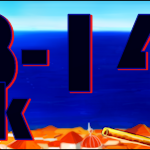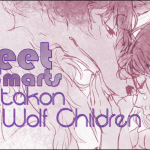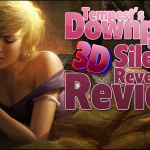Tempest’s Downpour – Howl’s Moving Castle
Film adaptations tend to stray from the original books to an extent. However, Hayao Miyazaki took Diana Wynne Jones’ themes and inserted the characters into a completely different storyline. The book and movie of Howl’s Moving Castle are two separate stories, with countless alterations, and several striking similarities.
The stories feature a similarly-named, though completely different cast of characters. In the book, the characters are nothing like how they first appear to be. Sophie starts off mousey and frightened, but winds up becoming the most strong-minded and powerful character in the book. Howl is a womanizing drama-queen and a proclaimed “slither-outer” who is wasteful and makes snide remarks towards Sophie in order to annoy her, although it is revealed that he honestly has Sophie’s best interests in mind at times.
Michael, the apprentice, is the most level-headed character, even though he is also the youngest at 15. Calcifer is a severe-looking fire demon, though he is honestly helpless while he remains bound by his contract with Howl. All are guided by personal desire, which winds up benefiting the group as a whole.
In this film, all of the heroic characters are exactly as they first appear to be, while all the villains are the opposite. From the moment Sophie first appears on the screen, she is the prototypical Miyazaki heroine: complete with saintly patience and limitless kindness. She is a bit more helpless than his typical heroines, which is strange because the Sophie of the books was much more capable. Howl is a good-natured but cocky wizard who helps out Sophie and winds up getting mixed up in this war business even though he is a pacifist.
Markl, once Michael in the book, is far younger than his book counterpart, but somehow more resourceful, as one would expect from a child in a Miyazaki film. Also, Calcifer became adorable, which is a striking difference from the pointy-toothed, blue-faced Calcifer of the book. Also, the Witch of the Waste remains an antagonist in the film, but takes on a far more grandmotherly role as she pretends to be senile after losing her powers.
Both stories start in the same direction: Sophie Hatter lives in the land of Ingary which is a magical town where any fairy tale could come true. Sophie, as the eldest sister, is doomed to lead a boring life, but winds up with exactly the opposite when the Witch of the Waste puts a curse on her that makes Sophie into an old woman. Sophie decides that she can’t continue her life as it is, and so ventures out into the world. She eventually finds shelter in Howl’s castle and begins working there as a cleaning lady.
From there, the plots go in two very distinct directions. The major conflicts of the book revolve around Howl’s attempts to evade and eventually fight the Witch of the Waste and her fire demon. The two represent what he and Calcifer are slowly becoming due to their contract. The overarching plot of the book is to surpass one’s destiny through courage, love and a series of seemingly well-placed accidents.
The major conflicts in the movie revolve around Howl’s stalwart pacifism in the face of his country’s war, and his fight not to become a monster like the other wizards who became soldiers. Although the major theme shoved down the throats of the viewers is “war is bad,” another major subject seems to be the fight not to follow through blindly.
Despite the fact that the storylines and characters are drastically different between the two versions, key themes from the book remained intact in the film. For example, in the book Howl metaphorically fought the monster he was becoming by battling with the Witch of the Waste and her demon, while the movie takes a more literal approach. The “little family” living in the castle certainly expands when Sophie adopts the man with the dog-curse, and in the film they take in Madame Sulliman’s dog and the Witch of the Waste as boarders. Also, Sophie winds up with stronger magical powers than Howl in both versions.
However, Miyazaki’s version left several gaping plotholes. The door to his castle opens to four different places: Porthaven, Kingsbury, the Waste, but the last one is never revealed. Sophie uses the door as a time-travel device after it has broken from a crash landing, but that’s just a malfunctioning door, not the final option. The Witch of the Waste never really explains why she turned Sophie old, and Sophie suddenly sprouts the magical ability to kiss something and make it all better with no explanation or foreshadowing. Also, the movie starts with rumors running about Howl devouring the hearts of women, but they don’t get explored or explained away.
A few surprising scenes sneaked into the film. Miyazaki retained the curse the Witch attempts to put on Howl in the form of John Dunne’s poem “Song: Go and Catch a Falling Star.” Miyazaki also graciously kept the scene where Howl throws a tantrum about his hair color and erupts in green slime, though this scene seemed strikingly out of place given how easygoing and kindhearted Miyazaki’s version of Howl was.
The shining moments of the film revolve around the little details, like in all Miyazaki’s films. All these details have been put together to make them jarringly un-Japanese. Sophie puts on her boots inside the house before she walks into Howl’s bedroom. Sophie also hugs and kisses other characters a considerable amount towards the end of the film, which is not an acceptable practice in Japanese culture.
Miyazaki’s version provided more closure with a happy ending and a flash of denouement: Michael running around in the courtyard of the new floating castle as Howl and Sophie share a Hollywood-style kiss. However, in the book a satisfactory ending has Sophie and Howl staring at each other as if for the first time and rather abruptly realizing that they will live happily ever after as friends and family crowd the two, poking them with questions.
As an original work of literature, Jones’ book is an outstanding fantasy work that is easy for the reader to comprehend and read through quickly. If this were an original work of Miyazaki’s, I’d give him much kudos and congratulations for imagining a world so different from the one he lives in. However, Miyazaki took a world imagined by someone else and changed the plot and characterization to better match his own style.
Sources:
Jones, Diana Wynne. Howl’s Moving Castle. New York: HarperCollins Publishers
Inc., 1986.
Howl’s Moving Castle. Hayao Miyazaki. Christian Bale, Leading
Billy Crystal, and Jean Simmons. Studio Ghibli, 2004.

















I was a Dianna Wynne Jones fan long before I was exposed to Miyazaki, but I still enjoyed both renditions. I often wonder why Miyazaki chose Howl’s story of all the dynamic worlds Dianna Wynne Jones has created.
I just loved Sophie’s character in the novel. I hope I’m a hale old woman, someday!!
wow I never knew that about Howls. Now I have to go read…or get a book on tape :3
“Miyazaki also graciously kept the scene where Howl throws a tantrum about his hair color and erupts in green slime, though this scene seemed strikingly out of place given how easygoing and kindhearted Miyazaki’s version of Howl was.”
I wouldn’t say it’s anyhow out of place, since it’s one of Miyazaki’s well-established trademarks to convey different, arguably conflicting sides of characters.